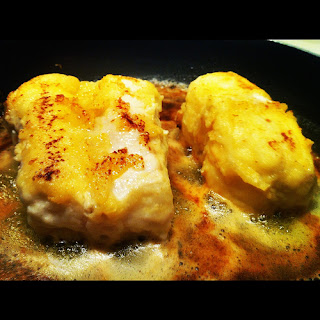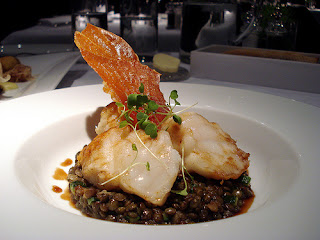from
Behind the French Menu
by
Bryan G. Newman
behindthefrenchmenu@gmail.com
Sauce Hollandaise and asparagus.
www.flickr.com/photos/donutgirl/6879640672/
Sauce Hollandaise
A mother sauce is a sauce that is used as a base for the creation of other sauces.
Those new sauces are her children.
Sauce Hollandaise is a sauce like no
other, its origins go back at least four-hundred years, but it is still the
sauce of choice for tens of dishes in Western cuisine. A mother sauce means
that the sauce’s recipe will be used to create other sauces, those sauces then
become her children. Mother sauces with Sauce Hollandaise include were first
clearly defined by the Chef Antonin
Carême in the early 1800s.
Sauce Hollandaise will be served either
alongside or as part of many dishes that include vegetables, fish and egg
dishes both hot and cold The recipe for Sauce Hollandaise is simple, it calls
for egg
yolks, melted butter,
lemon
juice, salt, and pepper.
(BTW Sauce Hollandaise has nothing to do
with Holland. In the early stages of French Haute Cuisine countries in the
1800s were being named any real connection was rarely required and that includes
Sauce Español, nothing to do with Spain and Sauce Allemande, nothing to do with
Germany).
Smoked
salmon with rocket and Sauce Hollandaise
Sauce Hollandaise on French Menus:
Les Belles Asperges
Blanches Juste Cuites Parfumées au Citron et Accompagnées de la Classique
Sauce Hollandaise – Beautiful white
asparagus, just lightly cooked, scented with lemon, and served with the
classic Hollandaise sauce. (Asparagus, should be like the best pasta,
al dente: in French perfectly cooked is à point).
Lobster
and pancetta over English muffin
topped with eggs and
Sauce Hollandaise.
www.flickr.com/photos/edsel_/7357879598/
Hollandaise sauce is my favorite sauce to accompany warm, fresh,
white, or green asparagus. For more about asparagus in
France see the post: Asperges
en La Cuisine Française – Asparagus in French cuisine.
Tronçon de Turbot
Label Rouge Poché Sauce Hollandaise ou Grillé Sauce Béarnaise. A wide cut of farm-raised, Label
Rouge turbot,
the fish, served either poached with a Sauce Hollandaise or grilled
and served with a Sauce Béarnaise.
The Label Rouge, the red label of
quality.
The Label Rouge, the red label, is a trusted, respected, and
well controlled French government label of quality; the label may be
awarded to all natural and manufactured food products with the exception of wine
which has its labeling regulation. The red label turbot offered above comes
from a French sea-farm; fish-farms that wish to apply for the label
rouge are continuously checked for their farming methods. Those controls
include the fish’s sanitary conditions; the food fed to the fish, and very
importantly, the density of the fish in their cages. Of equal importance are
the controls that prevent these fish from having any antibiotics and or
hormones in their food or environment.
Eggs Benedict with
smoked salmon and spinach
www.flickr.com/photos/ultrakml/8192609350/
Filets de Porc Grillée aux Champignons
avec Legumes, Sauce Hollandaise et Croquettes – Grilled fillets of pork and button
mushrooms served with vegetables and accompanied by Sauce
Hollandaise and croquet potatoes.
Smoked Haddock with
Sauce Hollandaise.
www.flickr.com/photos/goforchris/26072923290/
Dos de Merlu
à l' Unilatéral, Sauce Hollandaise – A thick cut of hake,
the fish, cooked à l'unilatéral, on the skin side only, and served with Sauce
Hollandaise.
N. B. Cooking fish à l'unilatéral is
considered the best way to cook thick filets of fish. Cooking slowly and only through
the skin side of the fish allows the fish to cook through evenly; this method eliminates much of the tastes of
the cooking oil as would cooking the fish on the open side of the filet.
Sauce Bearnaise, the
child of Hollandaise.
Among the many sauces developed
from Sauce Hollandaise it is Sauce
Béarnaise that really stands out. This child of Sauce
Hollandaise has itself become a mother sauce with many many grandchildren.
Steak
Frites with Sauce Bearnaise.
www.flickr.com/photos/flem007_uk/3625173675/
Unlike Sauce
Hollandaise where its creator is disputed Sauce Béarnaise is
accepted as the creation of the chef and restaurateur Jean Louis Françoise
Collinet. Collinet created Sauce Béarnaise as a child
of Sauce Hollandaise; Sauce Béarnaise is Sauce Hollandaise with the
lemon replaced by white wine vinegar, shallots, chervil and tarragon. Collinet is also remembered, by
some, as the chef who, in 1837,
created soufflé potatoes. The story of soufflé potatoes will be
left for another day,
Sauce Foyot, also
called Sauce Valois.
A sauce whose whose
creator I cannot find took Sauce Béarnaise and created Sauce Foyot, also
called Sauce Valois. Sauce Foyot is Sauce
Béarnaise with the addition of the glazed cooking juices
of roasted meat.
Sauce Choron.
The chef Alexandre Étienne Choron (1837 - 1924),
took Sauce Béarnaise and created Sauce Choron. Sauce
Choron is Sauce Béarnaise with added tomatoes.
European
sea bass cooked “en
croute”, in a pastry cover,
and served with Sauce Choron
www.flickr.com/photos/115081708@N03/31782191597/
Sauce Palois.
Then, yet another
chef whose name I cannot find took Sauce Béarnaise and created Sauce
Palois. Sauce Palois is Sauce
Béarnaise with the tarragon replaced with mint;
that makes Sauce Palois a very popular sauce to serve with lamb.
And the question remains, who created Sauce
Hollandaise?
The answer may lie
in the book noted below:
Le Vrai Cuisinier François,
The Real French Chef.
by
François Pierre de La Varenne (1618 -
1678)
The creator of Sauce Hollandaise is disputed but a recipe for a very similar sauce using vinegar, rather than lemon juice, does appear in this 17th century French cookbook: Le Vrai Cuisinier François.
The front page of
the original edition
Photograph courtesy
of the Biblotech National de France.
Go on-line to
the Biblotech National de France, http://gallica.bnf.fr and there in Le Vrai Cuisinier
François, by François Pierre de La Varenne, published
in 1654
on pages 254 and 255 you may
read, as I did, the recipe for Asperges à la Sauce Blanche, asparagus
with a white sauce.
You may download the whole book in PDF without payment, by keeping to a few simple
rules.
-----------------------
Behind the French Menu
by
Bryan G. Newman
behindthefrenchmenu@gmail.com
Copyright 2010, 2012,
2016, 2019.
---------------------------
Searching for the
meaning of words, names or phrases
on
French menus?
Just add the word, words, or phrase that
you are searching for to the words "Behind the French Menu" (best
when including the inverted commas), and search with Google or
Bing, Behind the French Menu’s links, include hundreds of words,
names, and phrases that are seen on French menus. There are over 450 articles
that include over 4,000 French dishes with English translations and
explanations.
----------------------------
Connected Posts:
Tomate
– Tomato. France’s Greatest Tomato, the Tomate de Marmande AOC. The Tomato in
French Cuisine.





















